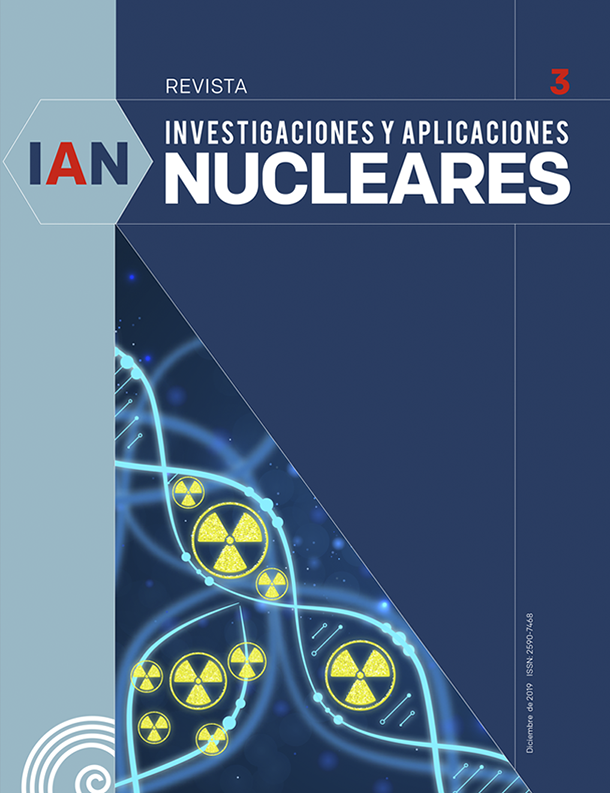Application of quality control protocols for fluoroscopy equipment in the cities of Tunja (Boyacá) and Bogotá
DOI:
https://doi.org/10.32685/2590-7468/invapnuclear.3.2019.507Keywords:
fluoroscopy, quality control, phantoms, angiographyDownloads
How to Cite
Issue
Section
Published
Abstract
Obtaining quality images in fluoroscopy depends, among other factors, on the skill of the technologist, the radiographic procedure and, especially, the performance of the equipment used. Regarding equipment performance, various quality control protocols have been developed that establish a set of tests to evaluate different parameters related to image quality and the dose received by the patient. The execution of these tests requires radiation detection equipment to evaluate electrical parameters and the quantity of radiation received by the patient as well as phantoms that allow for simulation of patients. These devices are quite expensive and are not available in the domestic market. Therefore, the performance of the equipment of several medical centers located in Tunja (Boyacá) and Bogotá, Capital District, was evaluated using prototypes manufactured domestically according to the recommendations of the American Association of Physicists in Medicine (AAPM) for skull phantoms in adults and based on anthropometric relationships. Execution of quality control protocols with the phantom prototypes indicated that all of the equipment performed in accordance with the tolerance limits and reference levels established in both protocols, with the exception of remote control equipment, which did not exhibit the desired spatial resolution tolerance. In general, among the evaluated equipment, the angiograph produced the best image quality, and the one that delivered the lowest dose to the patient was manufactured by Philips. Additionally, we established and documented for the first time a specific configuration for the development of quality control tests for angiography equipment.
References
.[1] Ministerio de Salud y Protección Social. Resolución 482 “Por la cual se reglamenta el uso de equipos generadores de radiación ionizante, su control de calidad, la prestación de servicios de protección radiológica y se dictan otras disposiciones”, Bogotá, 2018.
.[2] Sociedad Española de Física Médica, Sociedad Española de Protección Radiológica y Sociedad Española de Radiología Medica, “Protocolo Español de calidad en radiodiagnóstico”. Revisión 2011 (Aspectos Técnicos), 2011, pp. 47-61.
.[3] Acuerdo Regional de Cooperación para la Promoción de la Ciencia y la Tecnología Nuclear en Latinoamérica y el Caribe (ARCAL) XLIX, “Implementación de las normas Básicas de Seguridad Internacionales en las Prácticas Médicas, Protocolos de Control de Calidad en Radiodiagnóstico”, 2001, pp. 54-71.
.[4] M. R. Ruiz. Tablas antropométricas infantiles. Bogotá, Universidad Nacional de Colombia, Facultad de Artes, 2008.
.[5] W. R. Hendee, “X rays in medicine”, Physics Today, vol. 48, n.° 11. pp. 48-51, 1995. https://doi.org/10.1063/1.881440
.[6] J. E. Turner, “Interaction of Photons with Matter”, En Atoms, radiation, and radiation protection. Third Edition. Wiley-VCH, 2008, pp. 173-177. https://doi.org/10.1002/9783527616978.ch8
.[7] E. B. Podgorsak, “Interactions of Photons with Matter”, En Radiation physics for medical physicists. Springer-Verlag, 2006, pp. 277-355. https://doi.org/10.1007/978-3-642-00875-7
.[8] Organismo Internacional de Energía Atómica, Protección radiológica de los pacientes: fluoroscopia [Online]. Disponible en https://rpop.iaea.org/RPOP/RPoP/Content-es/InformationFor/HealthProfessionals/1_Radiology/Fluoroscopy.htm.
.[9] A. Brosed (ed.), Fundamentos de física médica. Vol. 2: Radiodiagnóstico: bases físicas, equipos y control de calidad. Madrid : SEFM, Universidad Internacional de Andalucía. 2004, p. 2.
.[10] R. Y. L. Chu, J. Fisher, B. R. Archer, B. J. Conway, M. M. Goodsitt, S. Glaze, J. E. Gray, K. J. Strauss, “Standardized Methods for Measuring Diagnostic X-ray Exposures”. American Institute of Physics; New York, NY, USA: AAPM Report 31, 1990.
.[11] A. Schreiner-Karoussou, “Review of image quality standards to control digital X-ray systems”. Radiation Protection Dosimetry, vol. 117, no. 1-3, pp. 23-25, 2005. https://doi.org/10.1093/rpd/nci722







